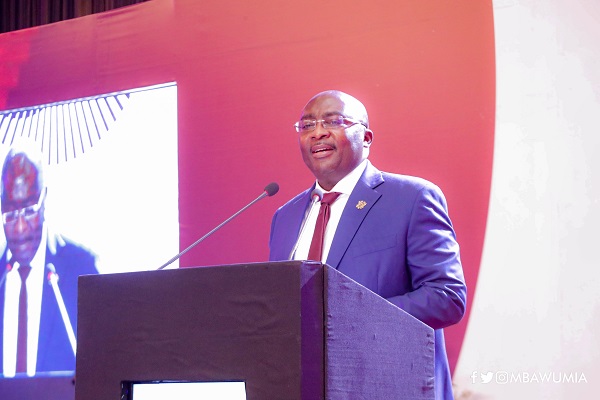Vice-president, Dr Mahamudu Bawumia has said although the COVID-19 pandemic has shaken the strong foundation of the Ghanaian economy, the growth of the economy is fundamentally stronger than it was in the 2013-2016 period.
Speaking on the state of the economy at the TESCON national conference on Thursday (7 April) in Kasoa, Dr Bawumia said “the path of inflation in Ghana has been similar to those of other countries following the COVID pandemic. Inflation had declined from an average of 17.5% in 2016 to an average of 7.2% in 2020. Since the pandemic, inflation has increased to an average of 10% in 2021.”
“As of February 2022 inflation 15 rose further to 15.7% as a result of global conditions, including a rise in crude oil and other commodity prices and the Russian-Ukraine conflict. It is important to note that between 2013 and 2016 inflation averaged 15.9%. Between 2017 and 2021, however, inflation has averaged 10.4% notwithstanding the impact of COVID-19.”
Interest rates
Bawumia said notwithstanding COVID-19, interest rates are lower now than they were in the 2013 -2016 period.
“Before COVID-19, the steady disinflation process provided scope for significant monetary policy easing. The Bank of Ghana’s Monetary Policy Rate (MPR) was cut by a cumulative 11% between January 2017 and January 2021.”
“This translated into a reduction in short term interest rates, with the interest rate on the 91-day Treasury bill declining from an average of 21.2% between 2013 and 2016 to an average of 13.8% between 2017 and 2021. Lending rates have also fallen from an average of 28% between 2013 and 2016 to an average of 23% between 2017 and 2021,” he said.
Bawumia added that in response to the recent increase in inflation, the Bank of Ghana has increased the policy rate by 2.5% from 14.5% to 17.0%.
Fiscal balance and debt
Bawumia said the robust fiscal discipline under the Akufo-Addo led administration is a contributing factor to the country’s strong economic fundamentals.
“The developments in the fiscal balance show a remarkable and sharp dichotomy between the fiscal deficit (ie. the 23 differences between government revenue and government expenditure) before the COVID-19 and after COVID-19. The fiscal deficit between 2013 and 2016 averaged 7% of GDP. Between 2017 and 2019 (before COVID-19), the fiscal deficit declined to an average of 4.5%.”
“For the first time in a decade, Ghana recorded primary balance surpluses (for three years in a row). To sustain the path of fiscal discipline, parliament passed into law a Fiscal Responsibility Act that limits the fiscal deficit in any year to a maximum of 5% of GDP and requires a positive primary balance (that is our tax revenues should exceed all government spending, excluding debt service payments),” he said.
External Sector Performance
He added that the country’s external sector performance is the strongest as compared to the trade deficit of US$1.7 billion recorded from 2013 to 2016.
“Ghana’s external payments position strengthened in the 2017-2021 period relative to the 2013-2016 years. For the first time in over 30 years, the trade balance (the difference between what we export and what we import) recorded a surplus for five successive years,” he said.
“The trade balance was in the deficit between 2013 and 2016 but moved from a deficit of US$1.7 billion in 2016 to a surplus of US$1.1 billion in 2017, a larger surplus of $1.8 billion in 2018, and an even larger surplus of US$2.2 billion in 2019. The impact of 19 COVID-19 has seen a reduction of the surplus to US$2.04 billion in 2020 and a further reduction to US$1.1 billion in 2021.
“…Nevertheless, this is still a much stronger performance than the trade deficit of US$1.7 billion recorded in 2016 (which was one of the stronger performances in the 2013-2016 period.”
Source: Daily Mail GH





